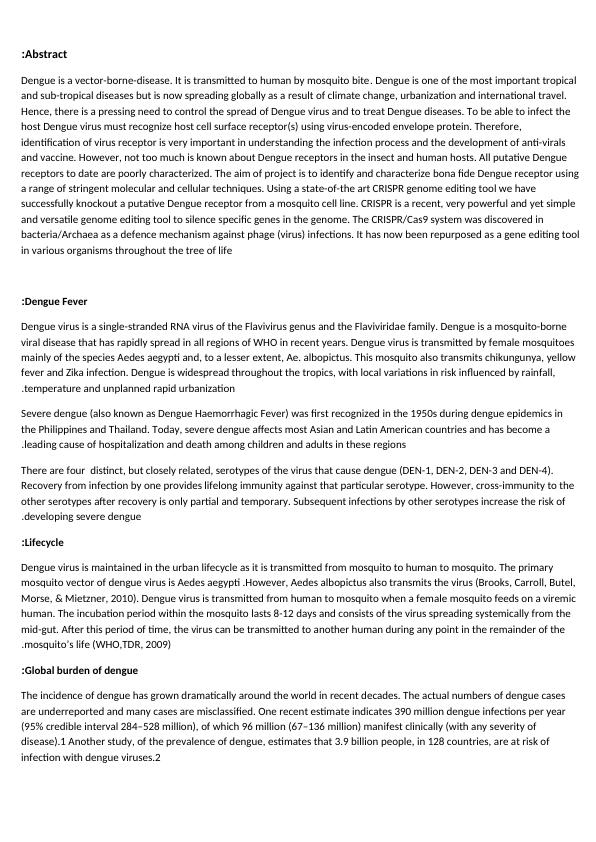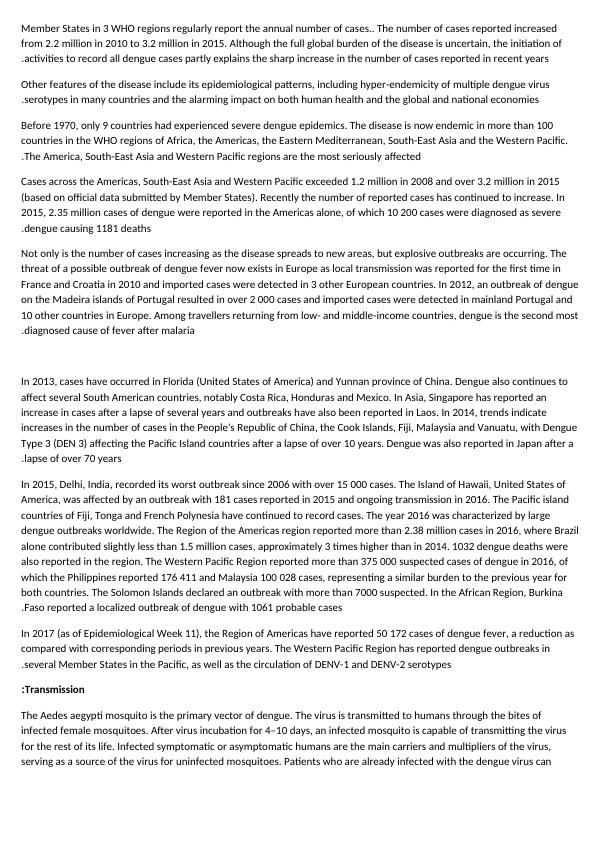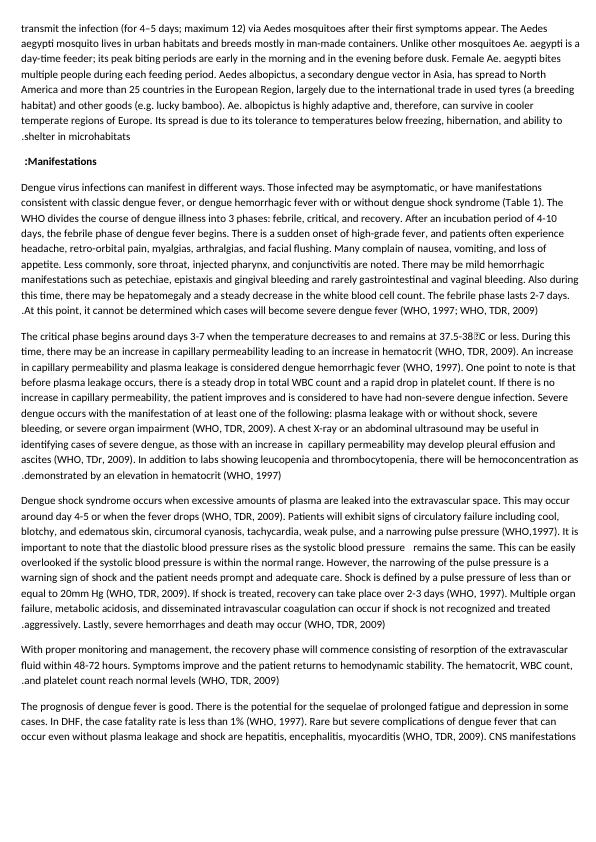Ask a question from expert
Dengue Fever: Symptoms, Transmission, and Global Burden
14 Pages9196 Words318 Views
Added on 2019-10-18
About This Document
Dengue fever is a mosquito-borne viral disease that has rapidly spread in all regions of WHO in recent years. Learn about the symptoms, transmission, and global burden of dengue fever. Find out how to identify and treat this mosquito-borne viral disease.
Dengue Fever: Symptoms, Transmission, and Global Burden
Added on 2019-10-18
BookmarkShareRelated Documents
Abstract:Dengue is a vector-borne-disease. It is transmitted to human by mosquito bite. Dengue is one of the most important tropical and sub-tropical diseases but is now spreading globally as a result of climate change, urbanization and international travel. Hence, there is a pressing need to control the spread of Dengue virus and to treat Dengue diseases. To be able to infect the host Dengue virus must recognize host cell surface receptor(s) using virus-encoded envelope protein. Therefore, identification of virus receptor is very important in understanding the infection process and the development of anti-virals and vaccine. However, not too much is known about Dengue receptors in the insect and human hosts. All putative Dengue receptors to date are poorly characterized. The aim of project is to identify and characterize bona fide Dengue receptor usinga range of stringent molecular and cellular techniques. Using a state-of-the art CRISPR genome editing tool we have successfully knockout a putative Dengue receptor from a mosquito cell line. CRISPR is a recent, very powerful and yet simple and versatile genome editing tool to silence specific genes in the genome. The CRISPR/Cas9 system was discovered in bacteria/Archaea as a defence mechanism against phage (virus) infections. It has now been repurposed as a gene editing toolin various organisms throughout the tree of lifeDengue Fever:Dengue virus is a single-stranded RNA virus of the Flavivirus genus and the Flaviviridae family. Dengue is a mosquito-borne viral disease that has rapidly spread in all regions of WHO in recent years. Dengue virus is transmitted by female mosquitoes mainly of the species Aedes aegypti and, to a lesser extent, Ae. albopictus. This mosquito also transmits chikungunya, yellow fever and Zika infection. Dengue is widespread throughout the tropics, with local variations in risk influenced by rainfall, temperature and unplanned rapid urbanization.Severe dengue (also known as Dengue Haemorrhagic Fever) was first recognized in the 1950s during dengue epidemics in the Philippines and Thailand. Today, severe dengue affects most Asian and Latin American countries and has become a leading cause of hospitalization and death among children and adults in these regions.There are four distinct, but closely related, serotypes of the virus that cause dengue (DEN-1, DEN-2, DEN-3 and DEN-4). Recovery from infection by one provides lifelong immunity against that particular serotype. However, cross-immunity to the other serotypes after recovery is only partial and temporary. Subsequent infections by other serotypes increase the risk of developing severe dengue.Lifecycle:Dengue virus is maintained in the urban lifecycle as it is transmitted from mosquito to human to mosquito. The primary mosquito vector of dengue virus is Aedes aegypti .However, Aedes albopictus also transmits the virus (Brooks, Carroll, Butel, Morse, & Mietzner, 2010). Dengue virus is transmitted from human to mosquito when a female mosquito feeds on a viremic human. The incubation period within the mosquito lasts 8-12 days and consists of the virus spreading systemically from the mid-gut. After this period of time, the virus can be transmitted to another human during any point in the remainder of the mosquito’s life (WHO,TDR, 2009).Global burden of dengue:The incidence of dengue has grown dramatically around the world in recent decades. The actual numbers of dengue cases are underreported and many cases are misclassified. One recent estimate indicates 390 million dengue infections per year (95% credible interval 284–528 million), of which 96 million (67–136 million) manifest clinically (with any severity of disease).1 Another study, of the prevalence of dengue, estimates that 3.9 billion people, in 128 countries, are at risk of infection with dengue viruses.2

Member States in 3 WHO regions regularly report the annual number of cases.. The number of cases reported increased from 2.2 million in 2010 to 3.2 million in 2015. Although the full global burden of the disease is uncertain, the initiation of activities to record all dengue cases partly explains the sharp increase in the number of cases reported in recent years.Other features of the disease include its epidemiological patterns, including hyper-endemicity of multiple dengue virus serotypes in many countries and the alarming impact on both human health and the global and national economies.Before 1970, only 9 countries had experienced severe dengue epidemics. The disease is now endemic in more than 100 countries in the WHO regions of Africa, the Americas, the Eastern Mediterranean, South-East Asia and the Western Pacific. The America, South-East Asia and Western Pacific regions are the most seriously affected.Cases across the Americas, South-East Asia and Western Pacific exceeded 1.2 million in 2008 and over 3.2 million in 2015 (based on official data submitted by Member States). Recently the number of reported cases has continued to increase. In 2015, 2.35 million cases of dengue were reported in the Americas alone, of which 10 200 cases were diagnosed as severe dengue causing 1181 deaths.Not only is the number of cases increasing as the disease spreads to new areas, but explosive outbreaks are occurring. The threat of a possible outbreak of dengue fever now exists in Europe as local transmission was reported for the first time in France and Croatia in 2010 and imported cases were detected in 3 other European countries. In 2012, an outbreak of dengueon the Madeira islands of Portugal resulted in over 2 000 cases and imported cases were detected in mainland Portugal and 10 other countries in Europe. Among travellers returning from low- and middle-income countries, dengue is the second mostdiagnosed cause of fever after malaria.In 2013, cases have occurred in Florida (United States of America) and Yunnan province of China. Dengue also continues to affect several South American countries, notably Costa Rica, Honduras and Mexico. In Asia, Singapore has reported an increase in cases after a lapse of several years and outbreaks have also been reported in Laos. In 2014, trends indicate increases in the number of cases in the People's Republic of China, the Cook Islands, Fiji, Malaysia and Vanuatu, with Dengue Type 3 (DEN 3) affecting the Pacific Island countries after a lapse of over 10 years. Dengue was also reported in Japan after a lapse of over 70 years.In 2015, Delhi, India, recorded its worst outbreak since 2006 with over 15 000 cases. The Island of Hawaii, United States of America, was affected by an outbreak with 181 cases reported in 2015 and ongoing transmission in 2016. The Pacific island countries of Fiji, Tonga and French Polynesia have continued to record cases. The year 2016 was characterized by large dengue outbreaks worldwide. The Region of the Americas region reported more than 2.38 million cases in 2016, where Brazilalone contributed slightly less than 1.5 million cases, approximately 3 times higher than in 2014. 1032 dengue deaths were also reported in the region. The Western Pacific Region reported more than 375 000 suspected cases of dengue in 2016, of which the Philippines reported 176 411 and Malaysia 100 028 cases, representing a similar burden to the previous year for both countries. The Solomon Islands declared an outbreak with more than 7000 suspected. In the African Region, Burkina Faso reported a localized outbreak of dengue with 1061 probable cases.In 2017 (as of Epidemiological Week 11), the Region of Americas have reported 50 172 cases of dengue fever, a reduction as compared with corresponding periods in previous years. The Western Pacific Region has reported dengue outbreaks in several Member States in the Pacific, as well as the circulation of DENV-1 and DENV-2 serotypes.Transmission:The Aedes aegypti mosquito is the primary vector of dengue. The virus is transmitted to humans through the bites of infected female mosquitoes. After virus incubation for 4–10 days, an infected mosquito is capable of transmitting the virus for the rest of its life. Infected symptomatic or asymptomatic humans are the main carriers and multipliers of the virus, serving as a source of the virus for uninfected mosquitoes. Patients who are already infected with the dengue virus can

transmit the infection (for 4–5 days; maximum 12) via Aedes mosquitoes after their first symptoms appear. The Aedes aegypti mosquito lives in urban habitats and breeds mostly in man-made containers. Unlike other mosquitoes Ae. aegypti is aday-time feeder; its peak biting periods are early in the morning and in the evening before dusk. Female Ae. aegypti bites multiple people during each feeding period. Aedes albopictus, a secondary dengue vector in Asia, has spread to North America and more than 25 countries in the European Region, largely due to the international trade in used tyres (a breeding habitat) and other goods (e.g. lucky bamboo). Ae. albopictus is highly adaptive and, therefore, can survive in cooler temperate regions of Europe. Its spread is due to its tolerance to temperatures below freezing, hibernation, and ability to shelter in microhabitats.Manifestations:Dengue virus infections can manifest in different ways. Those infected may be asymptomatic, or have manifestations consistent with classic dengue fever, or dengue hemorrhagic fever with or without dengue shock syndrome (Table 1). The WHO divides the course of dengue illness into 3 phases: febrile, critical, and recovery. After an incubation period of 4-10 days, the febrile phase of dengue fever begins. There is a sudden onset of high-grade fever, and patients often experience headache, retro-orbital pain, myalgias, arthralgias, and facial flushing. Many complain of nausea, vomiting, and loss of appetite. Less commonly, sore throat,injected pharynx, and conjunctivitis are noted. There may be mild hemorrhagic manifestations such as petechiae, epistaxis and gingival bleeding and rarely gastrointestinal and vaginal bleeding. Also duringthis time, there may be hepatomegaly and a steady decrease in the white blood cell count. The febrile phase lasts 2-7 days. At this point, it cannot be determined which cases will become severe dengue fever (WHO, 1997; WHO, TDR, 2009).The critical phase begins around days 3-7 when the temperature decreases to and remains at 37.5-38C or less. During this time, there may be an increase in capillary permeability leading to an increase in hematocrit (WHO, TDR, 2009). An increase in capillary permeability and plasma leakage is considered dengue hemorrhagic fever (WHO, 1997). One point to note is that before plasma leakage occurs, there is a steady drop in total WBC count and a rapid drop in platelet count. If there is no increase in capillary permeability, the patient improves and is considered to have had non-severe dengue infection. Severe dengue occurs with the manifestation of at least one of the following: plasma leakage with or without shock, severe bleeding, or severe organ impairment (WHO, TDR, 2009). A chest X-ray or an abdominal ultrasound may be useful in identifying cases of severe dengue, as those with an increase in capillary permeability may develop pleural effusion and ascites (WHO, TDr, 2009). In addition to labs showing leucopenia and thrombocytopenia, there will be hemoconcentration asdemonstrated by an elevation in hematocrit (WHO, 1997).Dengue shock syndrome occurs when excessive amounts of plasma are leaked into the extravascular space. This may occur around day 4-5 or when the fever drops (WHO, TDR, 2009). Patients will exhibit signs of circulatory failure including cool, blotchy, and edematous skin, circumoral cyanosis, tachycardia, weak pulse, and a narrowing pulse pressure (WHO,1997). It isimportant to note that the diastolic blood pressure rises as the systolic blood pressure remains the same. This can be easily overlooked if the systolic blood pressure is within the normal range. However, the narrowing of the pulse pressure is a warning sign of shock and the patient needs prompt and adequate care. Shock is defined by a pulse pressure of less than or equal to 20mm Hg (WHO, TDR, 2009). If shock is treated, recovery can take place over 2-3 days (WHO, 1997). Multiple organ failure, metabolic acidosis, and disseminated intravascular coagulation can occur if shock is not recognized and treated aggressively. Lastly, severe hemorrhages and death may occur (WHO, TDR, 2009).With proper monitoring and management, the recovery phase will commence consisting of resorption of the extravascular fluid within 48-72 hours. Symptoms improve and the patient returns to hemodynamic stability. The hematocrit, WBC count, and platelet count reach normal levels (WHO, TDR, 2009).The prognosis of dengue fever is good. There is the potential for the sequelae of prolonged fatigue and depression in some cases. In DHF, the case fatality rate is less than 1% (WHO, 1997). Rare but severe complications of dengue fever that can occur even without plasma leakage and shock are hepatitis, encephalitis, myocarditis (WHO, TDR, 2009). CNS manifestations

of convulsions, spasticity, altered consciousness, and transient paralysis have been seen in some cases. Acute renal failure and hemolytic uremic syndrome are other rare findings (WHO, 1997).Treatment:The clinical course of dengue virus infection varies, and therefore, treatment is determined individually depending on a patient’s status. The most important aspects of treating a patient with DF are to recognize early signs of plasma leakage and to begin fluid therapy. A healthcare provider (HCP) must also recognize dengue shock syndrome and aggressively address theissues of shock, bleeding, and organ impairment (WHO, TDR, 2009).The decision to send a patient with DF home can be made if the patient is able to maintain adequate levels of fluid intake and output. The patient must also have stable hematocrit levels and show no warning signs of severe dengue. A treatment plan consists of fever control and drinking plenty of fluids containing electrolytes and sugar. NSAIDs are contraindicated due to the potential for hemorrhagic manifestations. Patients must meet with their HCP on a daily basis to be assessed for signs of illness progression. It is essential for HCPs to educate their patients on warning signs that necessitate prompt medical attention. These warning signs include shortness of breath, a fast pulse, severe abdominal pain, persistent vomiting, jaundice, cool and clammy extremities, lethargy, irritability, convulsions, significant bleeding (i.e. coffee-ground emesis or black stools), and no urine output for 4-6 hours (WHO, TDR, 2009).Patients may be admitted if warning signs are present, if there are co-existing conditions, or if they do not have a caregiver at home or means of transportation to a hospital should they experience warning signs. Pregnant women as well as infants with dengue virus infection should also be admitted. For a patient with warning signs, first the hematocrit must be measuredand then IV fluids should be aggressively administered. The patient’s status and hematocrit levels must be reevaluated and IV infusion rates may be adjusted accordingly. Vital signs and peripheral perfusion should be monitored until the patient has advanced to the recovery phase. Urine output, blood glucose, and organ function should also be monitored. In a patient whois admitted without warnings signs of severe dengue, IV fluid therapy should only be started if the patient cannot tolerate oral fluids. HCPs should watch for warning signs of severe dengue and measure the patient’s temperature, fluid intake and urine output, hematocrit and WBC and platelet counts (WHO, TDR, 2009).The last category of treatment is for those in the critical phase of dengue fever. Patients in the critical phase need emergency hospitalization. Those in this category have one or more of the following manifestations: dengue shock and/or fluid accumulation leading to respiratory distress, severe hemorrhage, and severe organ impairment. IV fluid resuscitation is essential and usually is the only intervention necessary for treatment of this phase. The goals of fluid resuscitation are to improve central and peripheral circulation and organ perfusion. If a patient is in shock, IV fluid resuscitation should be started and the patient must be monitored closely. If there is no improvement, the hematocrit must be measured. If the hematocrit is still high, a second bolus of fluids should be given. In a patient with shock refractory to treatment, a hematocrit that is lower than the initial reference hematocrit is indicative of bleeding. In this instance, a blood transfusion is needed immediately (WHO, TDR, 2009).Immunization:In late 2015 and early 2016, the first dengue vaccine, Dengvaxia (CYD-TDV) by Sanofi Pasteur, was registered in several countries for use in individuals 9-45 years of age living in endemic areas. WHO recommends that countries should consider introduction of the dengue vaccine CYD-TDV only in geographic settings (national or subnational) where epidemiological dataindicate a high burden of disease. Other tetravalent live-attenuated vaccines are under development in phase III clinical trials, and other vaccine candidates (based on subunit, DNA and purified inactivated virus platforms) are at earlier stages of clinical development. WHO provides technical advice and guidance to countries and private partners to support vaccine research and evaluation.

End of preview
Want to access all the pages? Upload your documents or become a member.
Related Documents
Dengue Fever: Transmission, Global Burden, and Manifestationslg...
|17
|9743
|166
Identification and Characterisation of Prohibitin-2 as a Receptor for Dengue Virus in Insect Celllg...
|5
|2790
|379
Article on Dengue: Doclg...
|11
|2881
|260
Genetically modifying insects to inhibit disease transmissionlg...
|7
|1497
|492
Diseases Ddrugs And Complicationslg...
|13
|3883
|23
Chikungunya and Dengue Fever Assignment PDFlg...
|7
|1578
|130